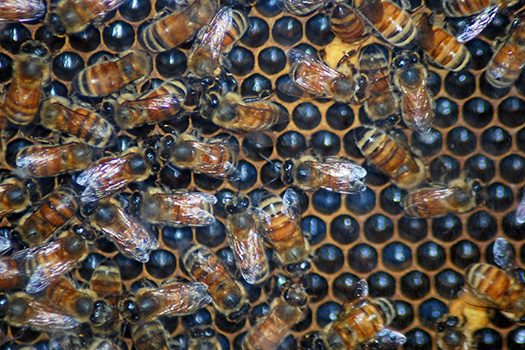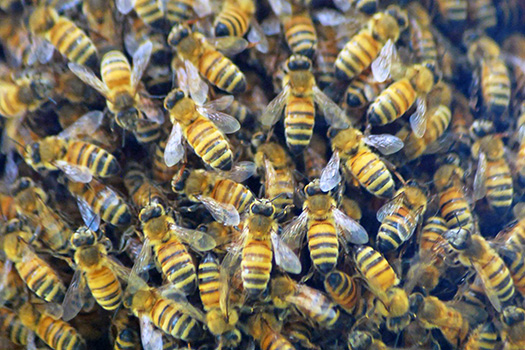Apis mellifera | European/Western Honeybee


Buzz Over to Meet Our Honeybees
Tiny, tireless, and absolutely essential, honeybees are among the most important pollinators on the planet! At the Zoo, you’ll find our buzzing colony in the Log Cabin within the Forgotten Forest. This small hive plays a vital role not only at the Zoo but in the greater ecosystem—making them a true conservation superstar in miniature form.
Inside the Hive: Honeybee Society
European honeybees are eusocial insects, which means that they live in an advanced social organization where there is only one reproductive female, while the rest of the group is nonreproductive that work together to care for the young. Each colony functions like a well-oiled machine, with thousands of bees working together for the survival of the hive.
The Three Castes:
- Queen – The hive’s one and only reproductive female, the queen can lay up to 1,000 eggs per day—over 200,000 in her lifetime. She also releases powerful pheromones that regulate hive activity. Queens can live 2–5 years.
- Workers – These female bees are the backbone of the colony. They build and maintain the hive, feed larvae, collect nectar and pollen, produce honey, and protect the nest. While workers typically live 2–4 weeks, those that survive the winter may live up to 11 months.
- Drones – Male bees have one job: to mate with a queen. After mating, they die. If they don’t mate, they’re evicted from the hive before winter. Their lifespan usually doesn’t exceed 4–8 weeks.
How Bees Communicate
Honeybees have an extraordinary and complex communication system:
- Pheromones – Bees rely on chemical signals to relay everything from threats to hive health.
- Sight – Their vision includes ultraviolet light, allowing them to see floral patterns invisible to humans.
- Vibrations & Temperature – Bees sense subtle vibrations and temperature changes to understand and respond to the hive’s needs.
- The Waggle Dance – This famous figure-eight dance shares the direction and distance to food sources. It’s one of the most unique communication systems in the insect world—a true GPS with wings!
Bees also use a unique hive “scent signature” to recognize members of their own colony. If an outsider tries to sneak in, guards will know.
And when a bee stings, it releases alarm pheromones that alert other bees to danger and direct them to the source.
Big Work for Small Wings
A single honeybee might visit up to 5,000 flowers in one day, and it takes around 2 million flower visits to produce just one pound of honey! All that effort doesn’t just make honey—it powers pollination.
In fact, 1 in every 3 bites of food we eat depends on pollinators like honeybees, including fruits, vegetables, nuts, coffee, and even chocolate.
At the Zoo, our bees forage from diverse landscapes and native flower gardens—especially those tended by our amazing volunteers, which also provide fun enrichment!
Bee Smart: Life Stages & Jobs
- Days 1–3: Clean cells for new eggs or food storage.
- Days 4–10: Feed the queen and larvae, fan the hive to regulate temperature, remove debris, and begin processing nectar.
- Around Week 2: Activate wax glands to help maintain the comb, continue feeding duties, or begin guarding the hive entrance.
- After Week 3: Transition to foraging—collecting nectar and spreading pollen among flowers.
The wax comb, made from secreted wax, forms the iconic hexagonal cells used to store honey, pollen, and developing young.
Wild vs. Domestic Bees
Our bees live in carefully maintained, man-made hives, and are tended by a Zoo volunteer. Wild honeybees, on the other hand, prefer natural shelters like tree hollows or rocky crevices.
While domestic bees are crucial for agriculture, wild bees—including bumblebees and solitary bees—are essential for ecological balance. Too many managed hives in one area can actually compete with native pollinators. That’s why conservationists emphasize protecting both domestic and wild bee populations. It’s not one or the other—it’s about balance.
Fact Sheet
Taxonomy
Species: Apis mellifera
Kingdom: Animalia | Phylum: Arthropoda | Class: Insecta | Order: Hymenoptera | Family: Apidae | Genus: Apis |
Favorite Enrichment Type
Our volunteer gardens, which provide the hive with a wide variety of native plants and flowers!
Life Span
- Queens: 2 to 5 years
- Workers: 4 to 6 weeks in summer and up to 6 months in winter
- Drones: 2 to 3 weeks or until they mate
Diet
- In the Wild: (Domesticated)
- At the Zoo: Pollen and nectar collected from plants and flowers throughout the Zoo.
Geographic Range
Africa, Europe, the Middle East, and Western Asia
Habitat
Meadows, open wooded areas, and gardens, but they can also survive in grasslands, deserts, and wetlands if there is enough water, food, and shelter.
Fast Facts
- Egg production: A queen can lay over 200,000 eggs in her lifetime.
- Communication: Honeybees use the waggle dance to share food locations.
- Busy bee: One bee may visit 5,000 flowers a day.
- Honey production: It takes 2 million flower visits to make just 1 pound of honey.
- Pollination: Bees pollinate 75% of flowering plants, including most of the crops we eat.
- Recognition: Honeybees can recognize human faces and remember patterns.
Status: Not Evaluated (Domesticated)
Conservation Buzz
Honeybees are facing growing threats, including:
- Pesticides
- Habitat Loss
- Climate Change
- Parasites like the Varroa mite
At the Zoo, we’re committed to helping pollinators thrive by:
- Maintaining native gardens.
- Offering pesticide-free foraging zones.
- Partnering with volunteers and educators to spread the buzz about bee conservation.
How You Can Help
When you plant native flowers, reduce pesticide use, and spread the word about pollinators, you’re helping the bees too.
Small actions lead to big changes—just like the honeybee.
How to Find Us
Our educational hive is in the Log Cabin, which overlooks the Mexican Wolf habitat in the Forgotten Forest. Take a cross-sectional look at our honeybee hive in action! You’ll see some of the world’s tiniest workers doing some of its most important jobs.
